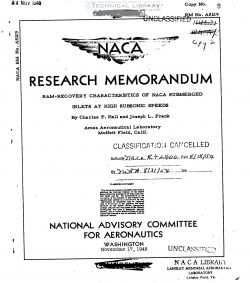naca-rm-a8i29
- Version
- 37 Downloads
- 1.63 MB File Size
- 1 File Count
- April 20, 2017 Create Date
- April 20, 2017 Last Updated
National Advisory Committee for Aeronautics, Research Memorandum - Ram-Recovery Characteristics of NACA Submerged Inlets at High Subsonic Speeds

Results are presented of an experimental investigation of the
ram—recovery characteristics of NACA submerged inlets on a model of
a fighter airplane at Mach numbers from 0.30 to 0.875. The effects
on the entrance ranbrecovery ratio of Mach number, angle of attack,
entrance mass flow, boundary—layer thickness on the fuselage, inlet
location, and boundary—layer deflectors are shown.
The data indicate only a slight decrease in ram—recovery ratio
for the inlets ahead of or Just behind the wing leading edge as Mach
number increased, but show large decreases at high Mach numbers for
the inlets aft of the point of maximum thickness of the wing. In
general, the ram—recovery ratio decreased with increasing angle of
attack. The ram—recovery ratio was a maximum at mass—flow ratios
between 0.60 and 0.80. Artificially increasing the boundary—layer
thickness or moving the inlets aft decreased the ram-recovery ratio.
Boundary—layer deflectors increased the maximum ram-recovery ratio
and the mass—flow ratio at which the maximm occurred.
A research program was conducted in the Ames 16—foot highpspeed
wim tunnel which, in conJunction with work in an Ames 7- by 10—foot
wind tunnel, continued the investigation of NASA submerged inlets
developed during the tests discussed in references 1 and 2. Attention
was concentrated on the inlet design found to have the most satisfac—
tory pressure-recovery characteristics during the tests of reference 1.
The effects of the following parameters on the pressure recovery at
the inlets were investigated.
A complete descriptiOn of the model was given in reference 3.
Briefly, the model (shown in figs. 1 and 2) was patterned to represent
a typical high—speed fighter airplane. Throughout the tests, a pair
of identical inlets was used. They were disposed symmetrically on
each side of the fuselage and connected to a common plenum chamber in
the aft part of the fuselage. The four longitudinal inlet locations
inyestigated (fig. 2) were at fuselage stations 34.25, h2.50, 50.75,
and 59.00 and corresponded, respectively, to 16.7 percent of the
root chord ahead of, and 8.3, 33.3, and 58.3 percent of the root
chord behind the wing-root leading edge. Dimensions of the ramp,
lip, and boundary—layer deflectors are shown in figure 3.
| File | Action |
|---|---|
| naca-rm-a8i29 Ram-Recovery Characteristics of NACA Submerged Inlets at High Subsonic Speeds.pdf | Download |

Comment On This Post